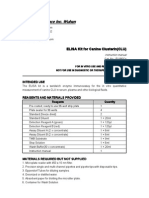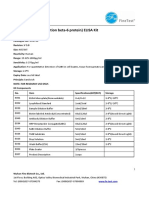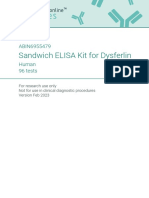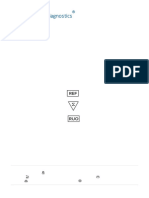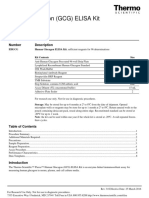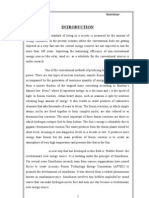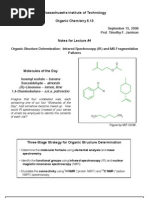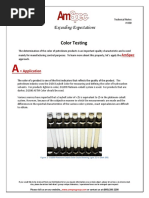Mouse IL-8 (Interleukin 8) ELISA Kit: Instruction Manual
Mouse IL-8 (Interleukin 8) ELISA Kit: Instruction Manual
Uploaded by
Aak An NasherCopyright:
Available Formats
Mouse IL-8 (Interleukin 8) ELISA Kit: Instruction Manual
Mouse IL-8 (Interleukin 8) ELISA Kit: Instruction Manual
Uploaded by
Aak An NasherOriginal Description:
Original Title
Copyright
Available Formats
Share this document
Did you find this document useful?
Is this content inappropriate?
Copyright:
Available Formats
Mouse IL-8 (Interleukin 8) ELISA Kit: Instruction Manual
Mouse IL-8 (Interleukin 8) ELISA Kit: Instruction Manual
Uploaded by
Aak An NasherCopyright:
Available Formats
Instruction manual
Mouse IL-8(Interleukin 8) ELISA Kit
Catalogue No.: EM1592
Size: 48T/96T
Reactivity: Mouse
Range:15.625-1000pg/ml
Sensitivity: <9.375pg/ml
Application: For quantitative detection of IL-8 in serum, plasma, tissue homogenates and other
biological fluids.
Storage: 4°C for 6 months
NOTE: FOR RESEARCH USE ONLY.
Kit Components
Item Specifications(48T/96T) Storage
Micro ELISA Plate(Dismountable) 8×6 or 8×12 4°C/-20°C
Lyophilized Standard 1 vial or 2 vial 4°C/-20°C
Sample / Standard dilution buffer 10ml/20ml 4°C
Biotin-detection antibody (Concentrated) 60ul/120ul 4°C
Antibody dilution buffer 5ml/10ml 4°C
HRP-Streptavidin Conjugate(SABC) 60ul/120ul 4°C(shading light)
SABC dilution buffer 5ml/10ml 4°C
TMB substrate 5ml/10ml 4°C(shading light)
Stop solution 5ml/10ml 4°C
Wash buffer (25X) 15ml/30ml 4°C
Plate Sealer 3/5pieces
Product Description 1 copy
Wuhan Fine Biological Technology Co., Ltd.
C6-323 Biolake, No.666Gaoxin AVE. Eastlake High-tech Development District, Wuhan, Hubei, China
Tel:(0086)027-87384275 Fax: (0086)027-87800889 www.fn-test.com
1/9
Instruction manual
Principle of the Assay
This kit was based on sandwich enzyme-linked immune-sorbent assay technology. Anti- IL-8
antibody was pre-coated onto 96-well plates. And the biotin conjugated anti-IL-8 antibody was
used as detection antibodies. The standards, test samples and biotin conjugated detection
antibody were added to the wells subsequently, and wash with wash buffer. HRP-Streptavidin
was added and unbound conjugates were washed away with wash buffer. TMB substrates were
used to visualize HRP enzymatic reaction. TMB was catalyzed by HRP to produce a blue color
product that changed into yellow after adding acidic stop solution. The density of yellow is
proportional to the IL-8 amount of sample captured in plate. Read the O.D. absorbance at
450nm in a microplate reader, and then the concentration of IL-8 can be calculated.
Precautions for Use
1. To inspect the validity of experiment operation and the appropriateness of sample dilution
proportion, pilot experiment using standards and a small number of samples is
recommended.
2. After opening and before using, keep plate dry.
3. Before using the Kit, spin tubes and bring down all components to the bottom of tubes.
4. Storage TMB reagents avoid light.
5. Washing process is very important, not fully wash easily cause a false positive.
6. Duplicate well assay is recommended for both standard and sample testing.
7. Don’t let Micro plate dry at the assay, for dry plate will inactivate active components on
plate.
8. Don’t reuse tips and tubes to avoid cross contamination.
9. Avoid using the reagents from different batches together.
Material Required but Not Supplied
1. Microplate reader (wavelength: 450nm)
2. 37°C incubator
3. Automated plate washer
4. Precision single and multi-channel pipette and disposable tips
5. Clean tubes and Eppendorf tubes
6. Deionized or distilled water
Wuhan Fine Biological Technology Co., Ltd.
C6-323 Biolake, No.666Gaoxin AVE. Eastlake High-tech Development District, Wuhan, Hubei, China
Tel:(0086)027-87384275 Fax: (0086)027-87800889 www.fn-test.com
2/9
Instruction manual
Manual Washing
Discard the solution in the plate without touching the side walls. Clap the plate on absorbent
filter papers or other absorbent material. Fill each well completely with 350ul wash buffer and
soak for 1 to 2 minutes, then aspirate contents from the plate, and clap the plate on absorbent
filter papers or other absorbent material. Repeat this procedure two more times for a total of
THREE washes.
Automated Washing
Aspirate all wells, then wash plate THREE times with350ulwash buffer. After the final wash,
invert plate, and clap the plate on absorbent filter papers or other absorbent material. It is
recommended that the washer be set for a soaking time of 1 minute.
Sample Collection and Storage
Isolate the test samples soon after collecting, then, analyze immediately (within 2 hours). Or
aliquot and store at -20°C for long term. Avoid multiple freeze-thaw cycles.
Serum: Allow samples to clot for 2 hours at room temperature or overnight at 4°C before
centrifugation for 20 minutes at approximately 1000×g. Collect the supernatant and carry
out the assay immediately. Blood collection tubes should be disposable, non-pyrogenic,
and non-endotoxin.
Plasma: Collect plasma using EDTA-Na2 as an anticoagulant. Centrifuge samples for 15
minutes at 1000×g at 2 - 8°C within 30 minutes of collection. Collect the supernatant and
carry out the assay immediately. Avoid hemolysis, high cholesterol samples.
Tissue homogenates: For general information, hemolysis blood may affect the result, so
you should rinse the tissues with ice-cold PBS (0.01M, pH=7.4) to remove excess blood
thoroughly. Tissue pieces should be weighed and then minced to small pieces which will be
homogenized in PBS (the volume depends on the weight of the tissue. 9mL PBS would be
appropriate to 1 gram tissue pieces. Some protease inhibitor is recommended to add into
the PBS.) with a glass homogenizer on ice. To further break the cells, you can sonicate the
suspension with an ultrasonic cell disrupter or subject it to freeze-thaw cycles. The
homogenates are then centrifugated for 5minutes at 5000×g to get the supernate.
Cell culture supernate: Centrifuge supernate for 20 minutes to remove insoluble impurity
and cell debris at 1000×g at 2 - 8°C. Collect the clear supernate and carry out the assay
immediately.
Other biological fluids: Centrifuge samples for 20 minutes at 1000×g at 2 - 8°C. Collect the
supernatant and carry out the assay immediately.
Sample preparation: Samples should be clear and transparent and be centrifuged to
remove suspended solids.
Wuhan Fine Biological Technology Co., Ltd.
C6-323 Biolake, No.666Gaoxin AVE. Eastlake High-tech Development District, Wuhan, Hubei, China
Tel:(0086)027-87384275 Fax: (0086)027-87800889 www.fn-test.com
3/9
Instruction manual
Note: Samples to be used within 5 days may be stored at 4°C,otherwise samples must be stored
at -20°C (≤1 month) or -80°C(≤2 months) to avoid loss of bioactivity and contamination.
Hemolyzed samples are not suitable for use in this assay.
Sample Dilution Guideline
End user should estimate the concentration of the target protein in the test sample first, and
select a proper dilution factor to make the diluted target protein concentration falls the optimal
detection range of the kit. Dilute the sample with the provided dilution buffer, and several trials
may be necessary in practice. The test sample must be well mixed with the dilu tion buffer. And
also standard curves and sample should be make in pre-experiment.
High target protein concentration (10000-100000pg/ml): Dilution: 1:100. (i.e. Add 1μl of
sample into 99 μl of Sample / Standard dilution buffer.)
Medium target protein concentration (1000-10000pg/ml): Dilution: 1:10.( i.e. Add 10 μl of
sample into 90 μl of Sample / Standard dilution buffer.)
Low target protein concentration (15.625-1000pg/ml): Dilution: 1:2.( i.e. Add 50 μl of
sample into 50 μl of Sample / Standard dilution buffer.)
Very low target protein concentration (≤15.625pg/ml): Unnecessary to dilute, or dilute at
1:2.
Reagent Preparation and Storage
Bring all reagents to room temperature before use.
1, Wash Buffer:
Dilute 30mL of Concentrated Wash Buffer into 750 mL of Wash Buffer with deionized or
distilled water. Put unused solution back at 4°C. If crystals have formed in the concentrate, you
can warm it with 40°C water bath (Heating temperature should not exceed 50°C) and mix it
gently until the crystals have completely dissolved. The solution should be cooled to room
temperature before use.
2, Standard:
1). 1000pg/ml of standard solution: Add 1 ml of Sample / Standard dilution buffer into one
Standard tube, keep the tube at room temperature for 10 min and mix thoroughly.
2).500pg/ml→15.625pg/ml of standard solutions: Label 6 Eppendorf tubes with500pg/ml,
250pg/ml, 125pg/ml, 62.5pg/ml, 31.25pg/ml, 15.625pg/ml, respectively. Aliquot 0.3 ml of the
Sample / Standard dilution buffer into each tube. Add 0.3 ml of the above1000pg/ml standard
solution into 1st tube and mix thoroughly. Transfer 0.3 ml from 1st tube to 2nd tube and mix
thoroughly. Transfer 0.3 ml from 2nd tube to 3rd tube and mix thoroughly, and so on .
Wuhan Fine Biological Technology Co., Ltd.
C6-323 Biolake, No.666Gaoxin AVE. Eastlake High-tech Development District, Wuhan, Hubei, China
Tel:(0086)027-87384275 Fax: (0086)027-87800889 www.fn-test.com
4/9
Instruction manual
Note: The standard solutions are best used within 2 hours. The standard solution should be at
4°C for up to12 hours. Or store at -20 °C for up to 48 hours. Avoid repeated freeze-thaw cycles.
3, Preparation of Biotin-detection Antibody working solution
prepare within 1 hour before the experiment.
1) Calculate the total volume of the working solution: 0.1 ml / well × quantity of wells. (Allow
0.1-0.2 ml more than the total volume)
2) Dilute the Biotin-detection antibody with Antibody dilution buffer at 1:100 and mix
thoroughly.(i.e. Add 1 μl of Biotin-detection antibody into 99 μl of Antibody dilution buffer.)
4, Preparation of HRP-Streptavidin Conjugate (SABC) working solution:
prepare within 30min before the experiment.
1) Calculate the total volume of the working solution: 0.1 ml / well × quantity of wells. (Allow
0.1-0.2 ml more than the total volume)
2) Dilute the SABC with SABC dilution buffer at 1:100 and mix thoroughly. (i.e. Add 1 μl of
SABC into 99 μl of SABC dilution buffer.)
Assay Procedure
Before adding to wells, equilibrate the SABC working solution and TMB substrate for at least 30
min at room temperature (37 °C). When diluting samples and reagents, they must be mixed
completely and evenly. It is recommend to plot a standard curve for each test.
1. Set standard, test sample and control (zero) wells on the pre-coated plate respectively, and
then, record their positions. It is recommend to measure each standard and sample in
duplicate. Wash plate 2 times before adding standard, sample and control (zero) wells!
2. Aliquot 0.1ml of1000pg/ml,500pg/ml, 250pg/ml, 125pg/ml, 62.5pg/ml, 31.25pg/ml,
15.625pg/ml, standard solutions into the standard wells.
3. Add 0.1 ml of Sample / Standard dilution buffer into the control (zero) well.
4. Add 0.1 ml of properly diluted sample (Mouse serum, plasma, tissue homogenates and
other biological fluids.) into test sample wells.
Wuhan Fine Biological Technology Co., Ltd.
C6-323 Biolake, No.666Gaoxin AVE. Eastlake High-tech Development District, Wuhan, Hubei, China
Tel:(0086)027-87384275 Fax: (0086)027-87800889 www.fn-test.com
5/9
Instruction manual
5. Seal the plate with a cover and incubate at 37 °C for 90 min.
6. Remove the cover and discard the plate content, clap the plate on the absorbent filter
papers or other absorbent material. Do NOT let the wells completely dry at any time. Do
Not Wash Plate!
7. Add 0.1 ml of Biotin-detection antibody working solution into the above wells (standard,
test sample & zero wells). Add the solution at the bottom of each well without touching
the side wall.
8. Seal the plate with a cover and incubate at 37°C for 60 min.
9. Remove the cover, and wash plate 3 times with Wash buffer.
10. Add 0.1 ml of SABC working solution into each well, cover the plate and incubate at
37°Cfor 30 min.
11. Remove the cover and wash plate 5 times with Wash buffer, and each time let the wash
buffer stay in the wells for 1-2 min.
12. Add 90 μl of TMB substrate into each well, cover the plate and incubate at 37°Cin dark
within 15-30 min. (Note: This incubation time is for reference use only, the optimal time
should be determined by end user.) And the shades of blue can be seen in the first 3 -4
wells (with most concentrated IL-8 standard solutions), the other wells show no obvious
color.
13. Add 50 μl of Stop solution into each well and mix thoroughly. The color changes into yellow
immediately.
14. Read the O.D. absorbance at 450 nm in a microplate reader immediately after adding the
stop solution.
For calculation, (the relative O.D.450) = (the O.D.450 of each well) – (the O.D.450 of Zero well).
The standard curve can be plotted as the relative O.D.450 of each standard solution (Y) vs. the
respective concentration of the standard solution (X). The IL-8 concentration of the samples can
be interpolated from the standard curve. Recommended to use professional software curve
expert to 1.3,for details, please visit: www.fn-test.com
Note: If the samples measured were diluted, multiply the dilution factor to the concentrations
from interpolation to obtain the concentration before dilution.
Summary
1. Wash plate 2 times before adding standard, sample and control (zero) wells!
2. Add 100μL standard or sample to each well for 90 minutes at 37°C
3. add 100μL Biotin-detection antibody working solution to each well for 60 minutes at 37°C
4. Aspirate and wash 3 times
5. Add 100μLSABCworking solution to each well. Incubate for 30 minutes at 37°C
Wuhan Fine Biological Technology Co., Ltd.
C6-323 Biolake, No.666Gaoxin AVE. Eastlake High-tech Development District, Wuhan, Hubei, China
Tel:(0086)027-87384275 Fax: (0086)027-87800889 www.fn-test.com
6/9
Instruction manual
6. Aspirate and wash 5 times
7. Add 90μLTMB substrate. Incubate 15 -30 minutes at 37°C
8. Add 50μL Stop Solution. Read at 450nm immediately
9. Calculation of results
Typical Data & Standard Curve
Results of a typical standard run of a IL-8 ELISA Kit are shown below. This standard curve was
generated at our lab for demonstration purpose only. Each user should obtain their own
standard curve as per experiment. (N/A=not applicable)
X pg/ml 0 15.625 31.25 62.5 125 250 500 1000
Y OD450 0.051 0.093 0.149 0.27 0.488 0.792 1.359 1.837
Specificity
This assay has high sensitivity and excellent specificity for detection of IL-8 . No significant
cross-reactivity or interference between IL-8 and analogues was observed.
Wuhan Fine Biological Technology Co., Ltd.
C6-323 Biolake, No.666Gaoxin AVE. Eastlake High-tech Development District, Wuhan, Hubei, China
Tel:(0086)027-87384275 Fax: (0086)027-87800889 www.fn-test.com
7/9
Instruction manual
Note: Limited by current skills and knowledge, it is impossible for us to complete the cross -
reactivity detection between IL-8 and all the analogues, therefore, cross reaction may still exist.
Recovery
Matrices listed below were spiked with certain level of IL-8 and the recovery rates were
calculated by comparing the measured value to the expected amount of IL-8 in samples.
Matrix Recovery range (%) Average(%)
serum(n=5) 88-98 94
EDTA plasma(n=5) 86-101 94
heparin plasma(n=5) 89-105 96
Linearity
The linearity of the kit was assayed by testing samples spiked with appropriate concentration of
IL-8 and their serial dilutions. The results were demonstrated by the percentage of calculated
concentration to the expected.
Sample 1:2 1:4 1:8 1:16
serum(n=5) 89-105% 93-100% 95-104% 92-104%
EDTA plasma(n=5) 82-100% 86-101% 82-101% 83-100%
heparin plasma(n=5) 82-89% 82-99% 85-100% 80-96%
Precision
Intra-assay Precision (Precision within an assay): 3 samples with low, middle and high level IL-8
were tested 20 times on one plate, respectively.
Inter-assay Precision (Precision between assays): 3 samples with low, middle and high level IL-8
were tested on 3 different plates, 8 replicates in each plate.
CV(%) = SD/meanX100
Intra-Assay: CV<8%
Inter-Assay: CV<10%
Stability
The stability of ELISA kit is determined by the loss rate of activity. The loss rate of this kit is less
than 10% within the expiration date under appropriate storage condition.
Wuhan Fine Biological Technology Co., Ltd.
C6-323 Biolake, No.666Gaoxin AVE. Eastlake High-tech Development District, Wuhan, Hubei, China
Tel:(0086)027-87384275 Fax: (0086)027-87800889 www.fn-test.com
8/9
Instruction manual
Standard(n=5) 37°C for 1 month 4°C for 6 months
Average(%) 80 95-100
To minimize extra influence on the performance, operation procedures and lab conditions,
especially room temperature, air humidity, incubator temperature should be strictly controlled.
It is also strongly suggested that the whole assay is performed by the same operator from the
beginning to the end.
Wuhan Fine Biological Technology Co., Ltd.
C6-323 Biolake, No.666Gaoxin AVE. Eastlake High-tech Development District, Wuhan, Hubei, China
Tel:(0086)027-87384275 Fax: (0086)027-87800889 www.fn-test.com
9/9
You might also like
- Principles of Pulse Electron Paramagnetic Resonance - Arthur Schweiger, Gunnar Jeschke (2001)Document301 pagesPrinciples of Pulse Electron Paramagnetic Resonance - Arthur Schweiger, Gunnar Jeschke (2001)hippimeNo ratings yet
- Lecture 7 Module DiffusionDocument56 pagesLecture 7 Module DiffusionAjit VashishtNo ratings yet
- Rat PDGF (Platelet-Derived Growth Factor) ELISA Kit: Instruction ManualDocument9 pagesRat PDGF (Platelet-Derived Growth Factor) ELISA Kit: Instruction ManualSigit Harya HutamaNo ratings yet
- Human DSP (Dentin Sialoprotein) ELISA KitDocument9 pagesHuman DSP (Dentin Sialoprotein) ELISA Kitmsk adiwiryaNo ratings yet
- Protocol: 190989 Dentin Sialoprotein (DSP) Bioassay™ Elisa Kit (Human)Document4 pagesProtocol: 190989 Dentin Sialoprotein (DSP) Bioassay™ Elisa Kit (Human)MSKANo ratings yet
- Elisa HistaminaDocument10 pagesElisa HistaminaLilia VERASNo ratings yet
- ABIN6975603 ManualDocument12 pagesABIN6975603 ManualAhmed AliNo ratings yet
- QS0009 MKDocument8 pagesQS0009 MKSales DiagindoNo ratings yet
- Rat Tumor Necrosis Factor α (TNF-α) ELISA KitDocument8 pagesRat Tumor Necrosis Factor α (TNF-α) ELISA KitSamuelNo ratings yet
- (Intended Use) : Instruction ManualDocument8 pages(Intended Use) : Instruction ManualTPNo ratings yet
- ELISA Kit For Angiotensin II (AngII) E90005RaDocument8 pagesELISA Kit For Angiotensin II (AngII) E90005RaTan Jie HuiNo ratings yet
- NERF2Document11 pagesNERF2BIOKITS BIOTECHNOLOGYNo ratings yet
- Human Interleukin 1, IL-1 ELISA KitDocument8 pagesHuman Interleukin 1, IL-1 ELISA KitAkanksha SinghNo ratings yet
- Elisa MethodDocument7 pagesElisa MethodNandia SeptiyoriniNo ratings yet
- ELISA Kit For Fetoprotein Alpha (AFP) E90153BoDocument8 pagesELISA Kit For Fetoprotein Alpha (AFP) E90153BoRo KohnNo ratings yet
- SL0018 DuDocument6 pagesSL0018 DuSales DiagindoNo ratings yet
- E1180Ca enDocument6 pagesE1180Ca enGentaur AntibodiesNo ratings yet
- SL1363Hu Human Permeability Glycoprotein, P-GP ELISA Kit (2) - 1Document7 pagesSL1363Hu Human Permeability Glycoprotein, P-GP ELISA Kit (2) - 1Dr-Dalya ShakirNo ratings yet
- Homocysteine ELISA KIT PDFDocument14 pagesHomocysteine ELISA KIT PDFRidwan AndragunaNo ratings yet
- Human PSA (Prostate Specific Antigen) ELISA Kit: 8th Edition, Revised in October, 2018Document12 pagesHuman PSA (Prostate Specific Antigen) ELISA Kit: 8th Edition, Revised in October, 2018audrey mappyNo ratings yet
- Elk4976 1Document17 pagesElk4976 1achmad.thoriqNo ratings yet
- SL0017 DuDocument6 pagesSL0017 DuSales DiagindoNo ratings yet
- Canine Adipocytokine Zinc Alpha 2 Glycoprotein (ZAG) Elisa KitDocument13 pagesCanine Adipocytokine Zinc Alpha 2 Glycoprotein (ZAG) Elisa KitMihael DraksicNo ratings yet
- ELK8634-1 (2)Document17 pagesELK8634-1 (2)Emmy MonnaNo ratings yet
- Elk0855 1Document17 pagesElk0855 1Thamer Ahmed ObeidatNo ratings yet
- Elabscience: (For Research Use Only. Do Not Use It in Clinical Diagnostics !)Document11 pagesElabscience: (For Research Use Only. Do Not Use It in Clinical Diagnostics !)Rachmi FadillahNo ratings yet
- SG-10139 Human Tumor Necrosis Factor Ligand Superfamily Member 14 (TNFSF14) ELISA KitDocument4 pagesSG-10139 Human Tumor Necrosis Factor Ligand Superfamily Member 14 (TNFSF14) ELISA KitAmrNo ratings yet
- SG-15714 Human Adenosine A2a Receptor (ADORA2A) ELISA KitDocument4 pagesSG-15714 Human Adenosine A2a Receptor (ADORA2A) ELISA KitAmrNo ratings yet
- SG-16448 Human V-Type Immunoglobulin Domain-Containing Suppressor of T-Cell Activation (VISTA) ELISA KitDocument4 pagesSG-16448 Human V-Type Immunoglobulin Domain-Containing Suppressor of T-Cell Activation (VISTA) ELISA KitAmrNo ratings yet
- ELISA Kit For Hepatocyte Growth Factor (HGF) SEA047HuDocument9 pagesELISA Kit For Hepatocyte Growth Factor (HGF) SEA047HuLink ZeldaNo ratings yet
- EH8788Document8 pagesEH8788Nurul Biladdil AsriNo ratings yet
- (Intended Use) : Instruction ManualDocument8 pages(Intended Use) : Instruction ManualNitin KeshavNo ratings yet
- (Intended Use) : Instruction ManualDocument8 pages(Intended Use) : Instruction ManualTPNo ratings yet
- CSB E13415hDocument14 pagesCSB E13415hhuripNo ratings yet
- Rat IL-10_(Cusabio)Document14 pagesRat IL-10_(Cusabio)j.renaudmenangaNo ratings yet
- SG-15702 Human Killer Cell Immnoglobulin Like Receptor (KIR) ELISA KitDocument4 pagesSG-15702 Human Killer Cell Immnoglobulin Like Receptor (KIR) ELISA KitAmrNo ratings yet
- (Intended Use) : Instruction ManualDocument8 pages(Intended Use) : Instruction ManualTPNo ratings yet
- Elisa KitDocument5 pagesElisa KitYani Nyiik0% (1)
- Sandwich ELISA Kit For Dysferlin: ABIN6955479Document11 pagesSandwich ELISA Kit For Dysferlin: ABIN6955479Trd FFNo ratings yet
- E5308Hu ManualDocument8 pagesE5308Hu ManualDhavalNo ratings yet
- MDA Kits For Rat For Researcher OnlyDocument14 pagesMDA Kits For Rat For Researcher OnlyPritta TaradipaNo ratings yet
- Human ESM1/Endocan ELISA Kit: Catalog No. EK0752 Size 96T (8×12 Divisible Strips)Document5 pagesHuman ESM1/Endocan ELISA Kit: Catalog No. EK0752 Size 96T (8×12 Divisible Strips)Okky Winang SaktyawanNo ratings yet
- Deia FN1437Document7 pagesDeia FN1437Sir BucketheadNo ratings yet
- ID-EH3991 Human IL-6 (Interleukin 6) ELISA KitDocument15 pagesID-EH3991 Human IL-6 (Interleukin 6) ELISA Kitcs.indogenNo ratings yet
- Rat CD4_Novus BiologicalsDocument11 pagesRat CD4_Novus Biologicalsj.renaudmenangaNo ratings yet
- Human Interleukin 15 ELISA Kit: Optimize Your ResearchDocument8 pagesHuman Interleukin 15 ELISA Kit: Optimize Your ResearchapriantaNo ratings yet
- ELISA Kit For Transforming Growth Factor Beta 1 (TGFb1) SEA124HuDocument10 pagesELISA Kit For Transforming Growth Factor Beta 1 (TGFb1) SEA124Hufaisal khanNo ratings yet
- ELISA Kit For Sirtuin 1 (SIRT1) SEE912HuDocument9 pagesELISA Kit For Sirtuin 1 (SIRT1) SEE912Hufitriani fajriNo ratings yet
- Protocolo de ELISA - IL-1 BetaDocument6 pagesProtocolo de ELISA - IL-1 BetamllboxNo ratings yet
- ELISA Kit For Vitamin D3 (VD3) CEA920GeDocument9 pagesELISA Kit For Vitamin D3 (VD3) CEA920Gebambang purwantoNo ratings yet
- Rat CD3_Novus BiologicalsDocument11 pagesRat CD3_Novus Biologicalsj.renaudmenangaNo ratings yet
- Optimize Your Research: Human Cross-Linked C-Terminal Telopeptides of Type II Collagen ELISA KitDocument8 pagesOptimize Your Research: Human Cross-Linked C-Terminal Telopeptides of Type II Collagen ELISA KitDebby Karina GirsangNo ratings yet
- Rat IL-6 (Elabscience)Document12 pagesRat IL-6 (Elabscience)j.renaudmenangaNo ratings yet
- Covid-19 Human Igm Igg Assay Kit: Catalog Number Ka5826 96 AssaysDocument9 pagesCovid-19 Human Igm Igg Assay Kit: Catalog Number Ka5826 96 AssaysZakia DrajatNo ratings yet
- chipDocument9 pageschipbidhanmalakar2015No ratings yet
- Human Glucagon ELISADocument8 pagesHuman Glucagon ELISA畏No ratings yet
- SG-11816 Human CD70 Antigen (CD70) ELISA KitDocument4 pagesSG-11816 Human CD70 Antigen (CD70) ELISA KitAmrNo ratings yet
- User Manual: Dog TSHB / Tsh-Beta Elisa Kit (Sandwich ELISA)Document22 pagesUser Manual: Dog TSHB / Tsh-Beta Elisa Kit (Sandwich ELISA)Julio Cesar MaceNo ratings yet
- NF KBDocument14 pagesNF KBBIOKITS BIOTECHNOLOGYNo ratings yet
- Rat Androgen Receptor (AR) ELISA Kit: Catalog Number. CSB-EL001975RADocument14 pagesRat Androgen Receptor (AR) ELISA Kit: Catalog Number. CSB-EL001975RANandia SeptiyoriniNo ratings yet
- Rabbit Alkaline Phosphatase (Alp) Elisa: K-AssayDocument7 pagesRabbit Alkaline Phosphatase (Alp) Elisa: K-AssayCristian CulcitchiNo ratings yet
- Flow charts of pharmaceutical quality control tests for different dosage formsFrom EverandFlow charts of pharmaceutical quality control tests for different dosage formsNo ratings yet
- Bubble Power ReportDocument23 pagesBubble Power ReportSenthil Kumar100% (1)
- Ch05 Rectilinear Motion PDFDocument24 pagesCh05 Rectilinear Motion PDFMuhammadKhalidRehanChNo ratings yet
- Adss Urbano Stock Spec - Adss12 - 2fo - FTDocument10 pagesAdss Urbano Stock Spec - Adss12 - 2fo - FTRoy BNo ratings yet
- Exam 4 2007 PDFDocument12 pagesExam 4 2007 PDFanon_281065744No ratings yet
- Perhitungan Pondasi Tiang PancangDocument9 pagesPerhitungan Pondasi Tiang PancangibnuNo ratings yet
- Test # 12.1 Physics-Ii: Superb in EducationDocument8 pagesTest # 12.1 Physics-Ii: Superb in EducationKamran AliNo ratings yet
- CuO Nanostructures - Synthesis, Characterization, Growth Mechanisms, Fundamental Properties, and ApplicationsDocument130 pagesCuO Nanostructures - Synthesis, Characterization, Growth Mechanisms, Fundamental Properties, and ApplicationsHanyuri VoNo ratings yet
- WenfengDocument22 pagesWenfengAudina Paramitha AzahraNo ratings yet
- Chapter 1Document10 pagesChapter 1Reydale Cacho100% (1)
- Silicone Compound Dm-3: Moisture Proofing Sealant & LubricantDocument1 pageSilicone Compound Dm-3: Moisture Proofing Sealant & LubricantvarunchNo ratings yet
- Gypsum ProductsDocument53 pagesGypsum ProductsKiran KumarNo ratings yet
- En QuantiTect SYBR Green PCR HandbookDocument32 pagesEn QuantiTect SYBR Green PCR Handbooknaini21No ratings yet
- 04 Lec HandoutDocument5 pages04 Lec HandoutmickeydeanNo ratings yet
- 02 Foliar Aguacate Toño Abril 20Document3 pages02 Foliar Aguacate Toño Abril 20Doky VanNo ratings yet
- Organic Chemistry AlcoholsDocument20 pagesOrganic Chemistry AlcoholsDante Luis SilvaNo ratings yet
- Kwaambwa 2007Document6 pagesKwaambwa 2007Larisa MocanuNo ratings yet
- Ftir Spectroscopy ThesisDocument8 pagesFtir Spectroscopy ThesisHelpWritingCollegePapersCanada100% (2)
- Cazón, P. Vázquez, M. Velazquez, G. Composite Films With UV-Barrier Properties Based On Bacterial Cellulose Combined With Chitosan and Poly (Vinyl AlcoholDocument36 pagesCazón, P. Vázquez, M. Velazquez, G. Composite Films With UV-Barrier Properties Based On Bacterial Cellulose Combined With Chitosan and Poly (Vinyl AlcoholanikbdtrainNo ratings yet
- Air Pollution Prevention and Control: Dr. Wesam Al MadhounDocument52 pagesAir Pollution Prevention and Control: Dr. Wesam Al MadhounAIZAZ SHAIKHNo ratings yet
- Universe and The Solar SystemDocument38 pagesUniverse and The Solar SystemPrecy Lyn UntalNo ratings yet
- LE Science7 Q1 Week-2 FinalDocument16 pagesLE Science7 Q1 Week-2 FinalGemma Puracan100% (1)
- 2.5 Bonding Forces and Energies: + Attractive ForceDocument1 page2.5 Bonding Forces and Energies: + Attractive Forcecesarmauricio427900No ratings yet
- S-Zorb (Conophillips) : Prepared By: Sadia Urooj Submitted To: Sir Zeeshan ZakiDocument4 pagesS-Zorb (Conophillips) : Prepared By: Sadia Urooj Submitted To: Sir Zeeshan ZakiSadia UroojNo ratings yet
- Lecture Notes On Heat and Mass TransferDocument517 pagesLecture Notes On Heat and Mass TransferSeetharam Tirumkudlu Ramarao100% (3)
- Vittorio Elia - Nuove Proprietà Fisico-Chimiche Dell'acquaDocument60 pagesVittorio Elia - Nuove Proprietà Fisico-Chimiche Dell'acquaweb3351No ratings yet
- All Tutorials ChE 313Document12 pagesAll Tutorials ChE 313Gio Albert BesaNo ratings yet
- PlasmonicsDocument18 pagesPlasmonicsdeeoakhldNo ratings yet
- Am Spec Color TestingDocument4 pagesAm Spec Color TestingNaeem KhanNo ratings yet
















